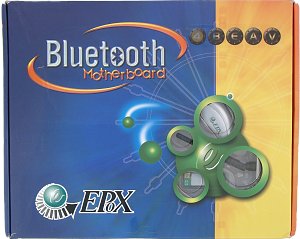EPoX 4BEAV
(i845E) Mainboard
|

This is a weird board as it combines gorgeousness and poverty. It uses the
aging ICH2 south bridge covered up with the USB 2.0 external controller and a
wireless connection set of two Bluetooth modules... The board has a wealth of settings
and space for several additional controllers and other interesting options but
these controllers are mostly not unsoldered... Accessories:
- Package of a new design;
- Documentation: user manual, guide
for Bluetooth module - in English;
- Cables: 1 ATA66/100/133 and
FDD;
- Bluetooth module installed onto the mainboard;
-
Bluetooth module connected to the USB port;

-
USB cable;
- Bracket with an antenna for the Bluetooth module;
-
Bracket with 2 USB ports;
- 2 CDs containing:
-
drivers;
- DirectX 7.0a;
- Adobe Acrobat Reader;
-
System monitoring programs;
- Boostek;
- Norton Ghost
7.0;
- PC-Cillin 2000.

The layout is not very good: the IDE connectors are behind the PCI slots while
the audio-ins are in front of them; the FDD connector located on the left edge
and the power supply's connector will hinder cooling of the computer, and an inserted
video card creates difficulties in handling memory modules. It's not difficult
to reach the only jumper when the board is already installed. Its function is
shown on the textolite. The 3-channel switching voltage regulator incorporates
6 capacitors of 3300 uF and 4 of 2200 uF. The following controllers are
integrated: - audio controller based on the chipset's capabilities
and ALC210A AC'97 codec supporting 4.1 audio systems;
- USB 2.0 bus
controller based on the VIA VT6202 chip.
Non-unsoldered connectors:
IEEE1394 bus controller and its connectors, network controller and RJ45 connector,
SD and MS flash card controllers and connectors, 2 7-segment POST controller diodes,
SPDIF connector. The system monitoring is supported by the Winbond WT83627HF-AW
chip. What is controlled: - processor voltage, +3.3, +-5 and +-12 V, VBAT,
+5 V Standby;
- speed of 3 fans;
- temperatures of the
processor (a built-in sensor), and the board (a built-in sensor).
There
are 3 connectors for adjustable connection of fans. Brief characteristics
of the board: memory slots - 3 DDR SDRAM; expansion slots - AGP/ 5 PCI; I/O
ports - 2 COM/ LPT/ 2 PS/2/ 6 USB 2.0; dimensions - 305x245 mm. Adjustment
can be carried out with:
| jumpers and switches | Jumper
to clear up the CMOS | | | BIOS based on AwardBIOS
6.00PG from Phoenix | Setup of memory timings | + | CAS
Latency, Active to Precharge Delay, RAS to CAS Delay, RAS Precharge |
| Setup of memory frequency | + | CPU:DRAM = Auto,
1:1, 3:4 | | Setup of AGP bus | - | |
| Setup of PCI bus | - | | | Changeable
scaler of AGP and PCI buses | + | AGP (PCIx2) = Auto,
66 MHz, 2/3 FSB | | Manual assignment of interrupts | + | |
| Changeable FSB frequency | + | 90 - 200 MHz in
1 MHz steps | | Changeable CPU multiplier | - | |
| Changeable core voltage | + | from -0.1 to +0.35
V in 0.025V steps | | Changeable memory voltage | + | +0.13,
+0.26, +0.4 V | | Changeable chipset voltage | - | |
| Changeable AGP bus voltage | + | +0.1, +0.2,
+0.3, +0.4 V | We used the latest available version of the
BIOS of 30/07/2002. The only idea that I have in my mind regarding such
a strange model is that the original solution was too dear, and the company decided
to stripe off all unnecessary stuff to maintain prices on a traditionally low
level. However, nothing important for home users is removed, and taking into account
a high speed, adjustability and the Bluetooth set, we can recommend it, especially,
if you are building a second computer system. Test results:
Write a comment below. No registration needed!
|
|



